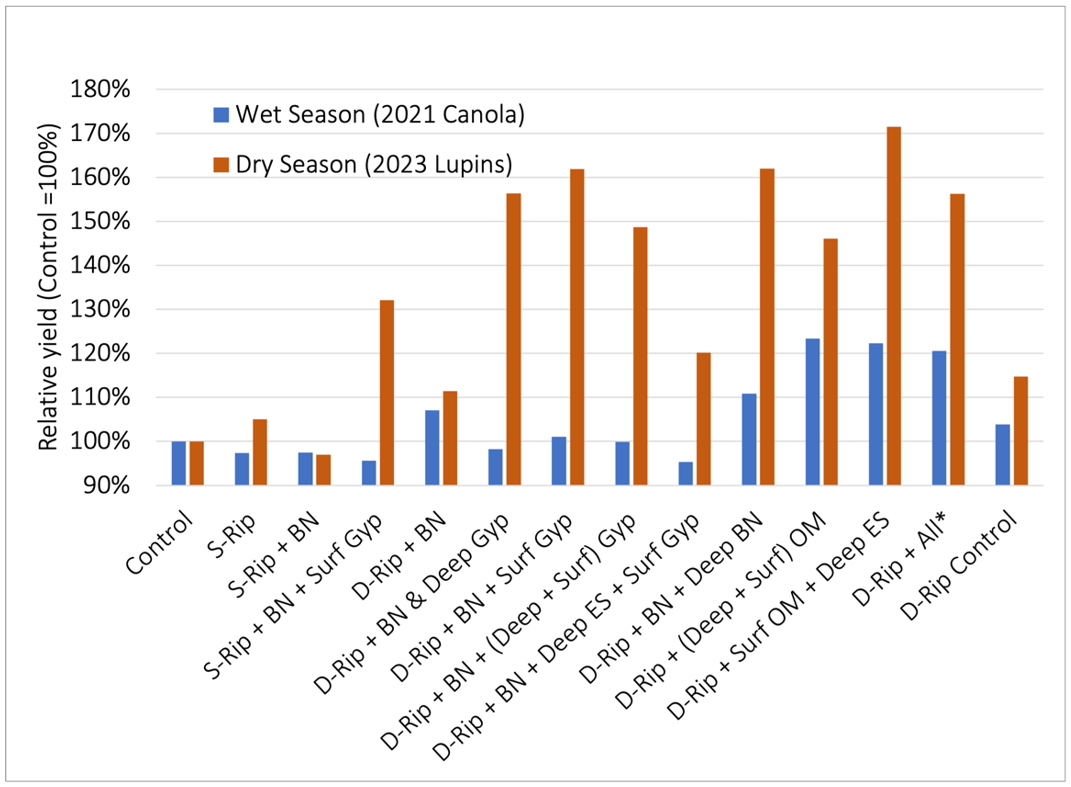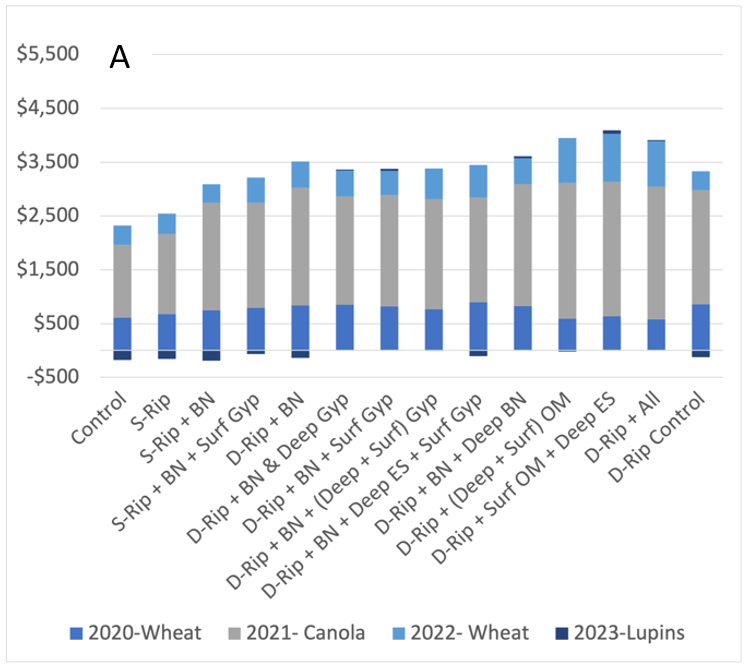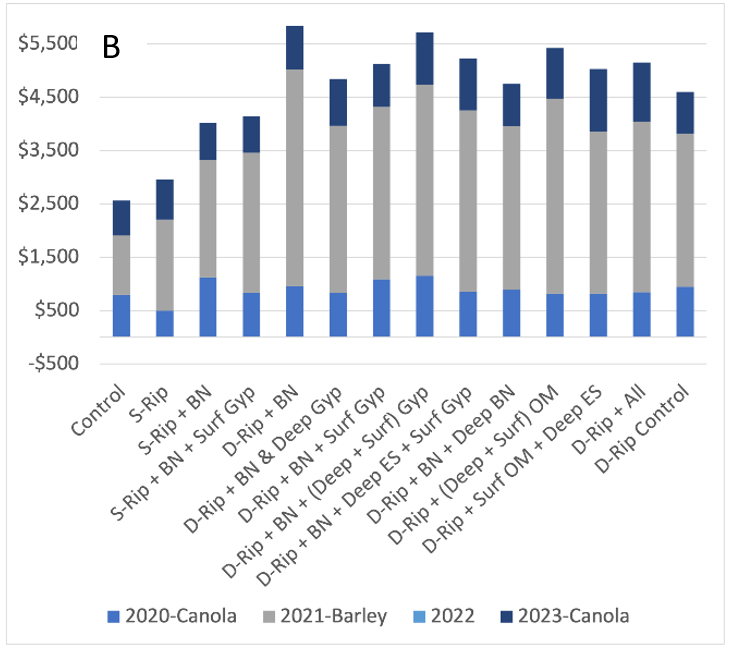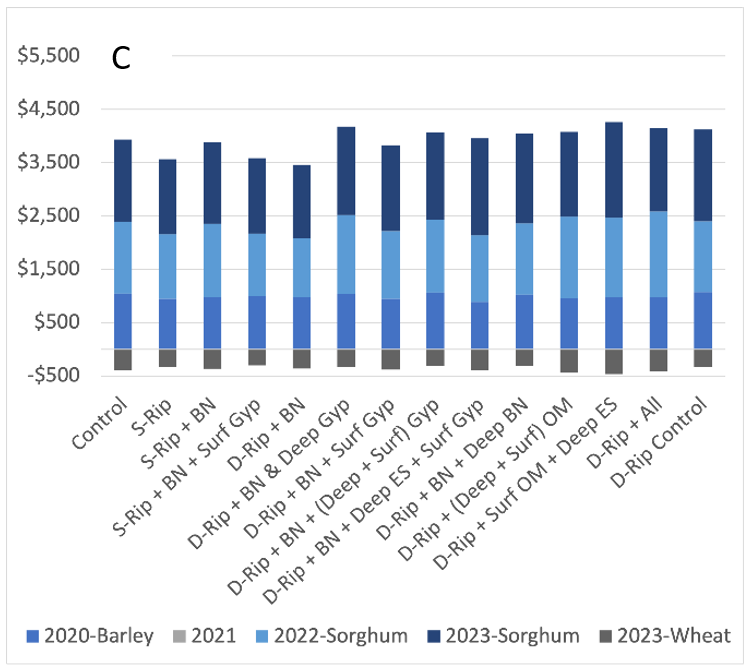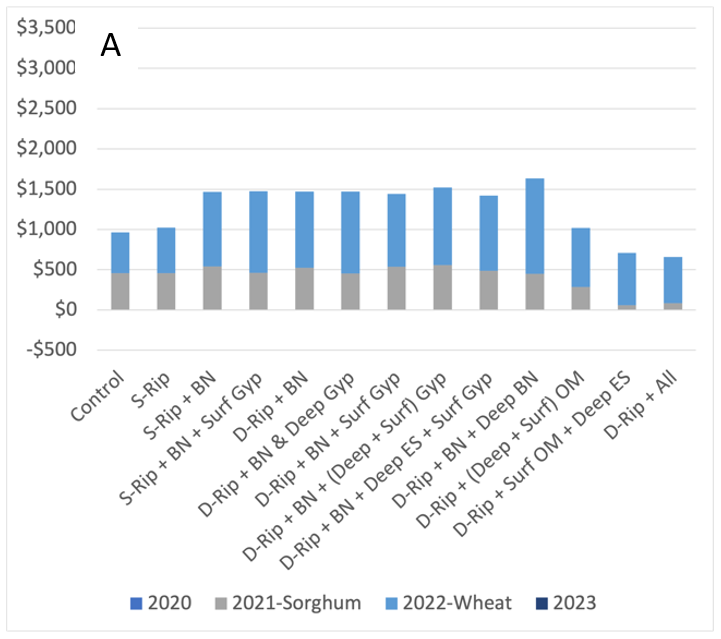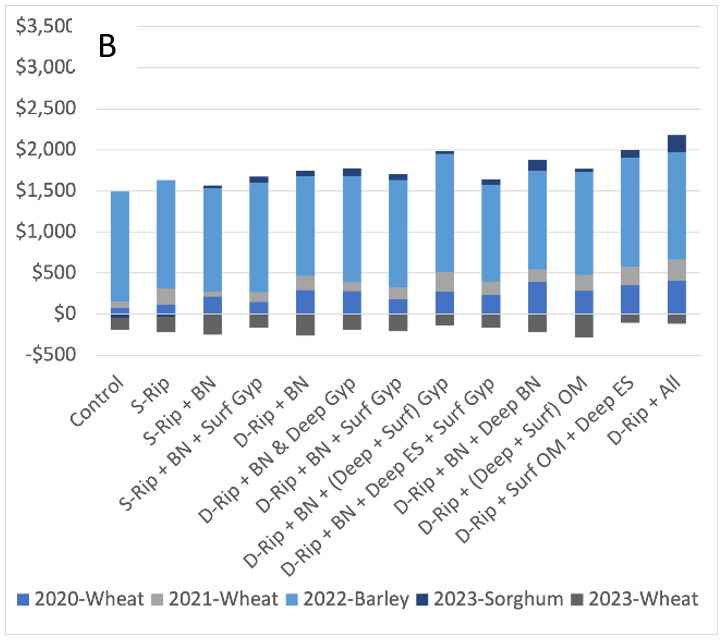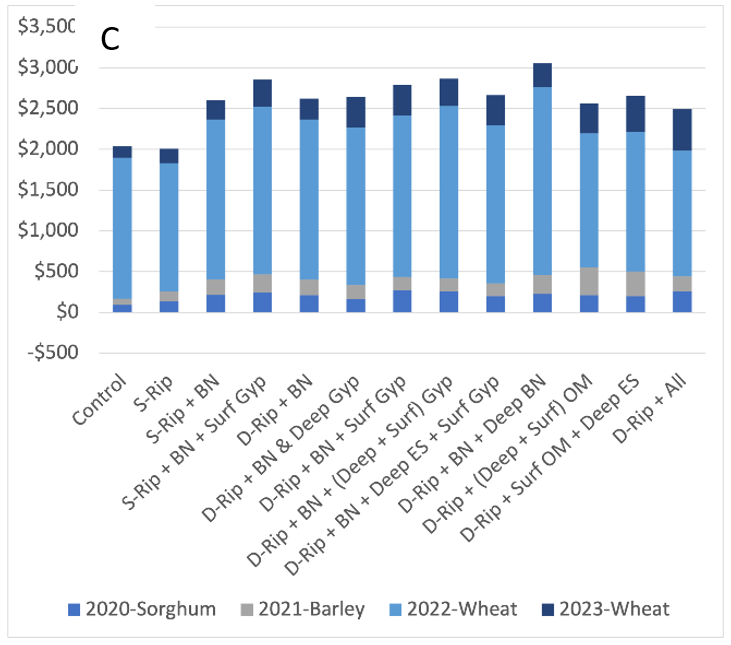Soil constraints project - an update on the economic response of long term soil amelioration strategies
Soil constraints project - an update on the economic response of long term soil amelioration strategies
Author: Richard Flavel (UNE), Craig Birchall (UNE), Mitchell Buster (UNE), Chris Guppy (UNE), David Lester (DAF Qld), Cameron Silburn (DAF Qld), David McKenzie (Soil Management Designs) | Date: 28 Feb 2024
Take home message
- Deep ripping compacted soils appears to have short term benefits but soil collapses shortly afterwards sometimes to a worse state than the original condition
- While tillage and nutrition treatments have stood out in historic wet seasons, the recent dry season indicates gypsum with ripping has improved water capture and yields
- Return on investment from treatments has occurred in shorter timeframes than expected
- Results from on-farm research trials indicate positive responses are soil dependent and the importance of finding the right solution for your soil.
Background
Vast amounts of soil in the northern grains region (NGR) are thought to be sodic, producing yield gaps between water-limited potential yield and currently achieved production (Hochman and Horan 2018, Orton 2018). This yield gap is a function of physical, chemical, and biological factors that reduce the capacity of soil to capture, store and release water and for plants to access water that has been stored. Many soils can be dispersive at many depths and can prevent root access through structural decline. Sodicity (a high exchangeable sodium percentage, ESP) is a major cause of aggregate dispersion and may compromise soil structure. Dispersive behaviour decreases both soil water availability and nutrient acquisition, increases risk of runoff and erosion, and impairs biological (soil microbial and plant root) activity. Acidity, salinity (both its presence through osmotic effects and its absence encouraging dispersion) and compaction further constrain yield potentials. The current project focuses on sodicity as the major constraint with often related constraints considered as compounding and/or interacting factors.
Amelioration of subsoil constraints is a challenging and expensive process. The benefits are likely to be seen through higher crop yields, arising from improved water storage and increased root access to stored water and nutrient availability. In wetter seasons, benefits may be observed by improved access to deep nutrition, however in poorer seasons where subsoil moisture is required to finish a crop, subsoil amelioration may have a larger impact on yield.
A series of linked investments is assessing the economics of ameliorating constrained surface and sub-surface soils in the NGR. The research into soil amelioration and management has two components; first is a set of six medium term (established in 2019) small-plot core experiments exploring mechanisms behind amelioration strategies (i.e., can sodicity be fixed). There are three sites in northern and central New South Wales (NSW) managed by the University of New England (UNE) located at Forbes, Armatree and Spring Ridge, and three sites in southern Qld managed by the Department of Agriculture and Fisheries (DAF) at Talwood, Millmerran and Dulacca. The second component of the investment is collaborating with growers (~20 sites) across the NGR with commercially relevant rates of ameliorant at commercially relevant scales to determine the feasibility of fixing soils on-farm.
This paper briefly reports on the field trial grain yield results from both the core site trials and on-farm research sites to-date and early responses to farm-scale implementation.
Core site experiments
The soils at the core sites have been comprehensively described in previous Update papers but are summarised below (Table 1). This research focussed on eliminating sodium as a constraint for the upper 50 cm of a soil profile. It was ‘proof-of-concept’ research, intended to explore effects on soil water storage and grain yield under various amelioration strategies.
Table 1. Brief site soil type description for core experimental sites
Site | Description |
|---|---|
Armatree | Red Sodosol, not dispersive (0-10cm) to dispersive (10-20) surface, to strongly alkaline and dispersive at depth, compact surface layers |
Forbes | Brown Vertosol, not dispersive (0-10cm) to dispersive (10-20) surface, to strongly alkaline and dispersive at depth |
Spring Ridge | Black Vertosol, moderate ESP and salinity in surface, increasing to high ESP and salinity at depth, but both are non-dispersive due to the salinity |
Talwood | Red/Brown Vertosol with surface soils not spontaneously dispersive, subsurface highly dispersive at 60-70cm |
Millmerran | Grey/Brown Vertosol, surface and subsurface soils not spontaneously dispersive, very compact soil through the profile. |
Dulacca | Grey/Brown Vertosol, surface soils not spontaneously dispersive but subsurface highly dispersive. |
Similar treatment structures are used in both NSW and Qld, with both physical and chemical ameliorants, a range of options exploring impacts and/or interactions between tillage (shallow and deep), deep placement of nutrients (as inorganic or organic forms), surface and subsurface applications of gypsum to reduce ESP to < 3%, incorporating organic amendments (lucerne pellets in NSW and composted feedlot manure in Qld), and applying elemental sulfur (ES) to decrease soil pH (Table 2). For subsoil amelioration, gypsum rates were compared with organic amendment compost (Qld)/lucerne pellet (NSW) application, and elemental sulfur to dissolve natural calcium carbonate to produce gypsum in-situ. Organic matter also acts to limit aggregate dispersion (as well as providing nutrients at depth) and, whilst not reducing ESP, may act to improve water holding capacity and pore stability. A detailed description of treatments is presented in a previous GRDC Grains Research Update paper (see further reading). Gypsum rates ranged from 2 to 30 t/ha depending on the magnitude of the sodicity at each site.
Table 2. Treatment structure for core soil constraints sites. Blue text (bold) indicates treatments applied across NSW sites only. Treatments were Shallow-rip (S-Rip), Deep-rip (D-Rip), Banded nutrients (BN), Surface and/or Deep gypsum (Surf Gyp/Deep Gyp), Surface and/or Deep organic ameliorant (feedlot manure Qld/ lucerne pellets NSW) (Surf OM/Deep OM) and Deep elemental sulfur (Deep ES). All treatment indicates all amendments were applied together except fertiliser.
Description | Rip | Fertiliser | Gypsum | Organic matter | Elemental sulfur |
|---|---|---|---|---|---|
Control | |||||
S-Rip | Shallow | ||||
S-Rip + BN | Shallow | Band | |||
S-Rip + BN + Surf Gyp | Shallow | Band | Surface | ||
D-Rip + BN | Deep | Band | |||
D-Rip + BN & Deep Gyp | Deep | Band | Deep | ||
D-Rip + BN + Surf Gyp | Deep | Band | Surface | ||
D-Rip + BN + (Deep + Surf) Gyp | Deep | Band | Surface + Deep | ||
D-Rip + BN + Deep ES + Surf Gyp | Deep | Band | Surface | Deep | |
D-Rip + BN + Deep BN | Deep | Surface + Band | |||
D-Rip + (Deep + Surf) OM | Deep | Surface + Deep | |||
D-Rip + Surf OM + Deep ES | Deep | Surface + Deep | Deep | ||
D-Rip + All | Deep | Surface + Deep | Surface + Deep | Deep | |
D-Rip Control | Deep |
Results and discussion
While treatment responses are highly dependent on the location, season, crop, and the longevity of each treatment, the average yield advantage (relative to the control) indicates global trends for the 2020-2023 seasons. Various crop rotations were chosen by the growers on whose sites the long-term trials are situated, and these are included in Figure 2 and 3 captions.
Armatree: Responded strongly to physical disturbance, particularly deep ripping. This site also responds well when ameliorated to depth, helping to retain the benefits from disturbance. Especially in the recent drier 2023 season, gypsum amendments have increased water use efficiency along with treatments including organic matter and elemental sulfur (which forms gypsum in situ as well as relieving alkaline pH constraints). The large and continuing contributions of the organic matter treatments (in the form of lucerne pellets) continue to provide a source of nutrition and while this is not a commercially economic treatment, the positive yield response suggests there are beneficial contributions of large organic N inputs to sustainable nutrient cycling.
Forbes: The main constraint is compaction and therefore this site is highly responsive to deep ripping and amendments. The benefit of the deep rip control treatment is declining over time but where ripping was combined with amendments to stabilise the physical effect, longer lasting benefits have been observed. Gypsum, elemental S and organic matter treatments are all improving yields.
Spring Ridge: Shrink-swell soil with some deep structural and salinity constraints. Generally, not a responsive site. Some response to treatments containing high nutrition (in wet seasons) and deep ripping, with some minor responses to deep gypsum. Responses in the winter crop-double crop (following sorghum) appear to be related to root access of unused water from the preceding sorghum crop, more than treatment effects acting to increase the amount of available water or increase water capture.
Talwood: Early responses to nutrition, particularly where deep P was applied. The composted manure does not appear to be benefiting crop growth in the same way as inorganic fertilisers, unlike the other Qld sites. Note that one of the only two crops planted was heavily affected by midge and mice and as the OM amendments resulted in earlier flowering, their yield was less impacted by damage from midge and mice, when compared to treatments which flowered later.
Millmerran: Strong responses to additional nutrition (including OM). In drier seasons, trends towards stronger performance from gypsum and OM treatments. Overall the addition of band nutrients and surface spread gypsum appear to be having the most consistent yield benefits.
Dulacca: Responses to deep ripping and nutrition with surface applied gypsum trending towards some benefit in drier seasons. Responses in the winter crop-double cropped (following sorghum) appear to be related to access of unused water from the preceding sorghum crop more than treatment effects on bucket size or recharge.
Table 3. Relative yield advantage (%) above the control by site averaged across the 2020-2023 growing seasons. Control values are made to represent 100% and all treatments above 100% are greater than the control across all seasons, while those lower than 100% on average yield lower than the control. Treatments were Shallow-rip (S-Rip), Deep-rip (D-Rip), Banded nutrients (BN), Surface and/or Deep gypsum (Surf Gyp/Deep Gyp), Surface and/or Deep organic ameliorant (feedlot manure Qld/ lucerne pellets NSW) (Surf OM/Deep OM) and Deep elemental sulfur (Deep ES). All treatment indicates all amendments were applied together except fertiliser.
| Relative yield advantage (%) above control yield for 2020-2023 | |||||
|---|---|---|---|---|---|---|
Treatment | Armatree | Forbes | Spring Ridge | Talwood | Dulacca | Millmerran |
Control | 100 | 100 | 100 | 100 | 100 | 100 |
S-Rip | 103 | 90 | 102 | 103 | 103 | 105 |
S-Rip + BN | 102 | 109 | 102 | 124 | 101 | 119 |
S-Rip + BN + Surf Gyp | 114 | 107 | 106 | 123 | 108 | 127 |
D-Rip + BN | 113 | 130 | 97 | 124 | 108 | 120 |
D-Rip + BN & Deep Gyp | 123 | 118 | 110 | 123 | 112 | 120 |
D-Rip + BN + Surf Gyp | 123 | 123 | 99 | 122 | 108 | 126 |
D-Rip + BN + (Deep + Surf) Gyp | 121 | 134 | 111 | 126 | 118 | 125 |
D-Rip + BN + Deep ES + Surf Gyp | 117 | 124 | 99 | 121 | 111 | 121 |
D-Rip + BN + Deep BN | 126 | 116 | 111 | 130 | 116 | 128 |
D-Rip + (Deep + Surf) OM | 129 | 126 | 96 | 100 | 107 | 130 |
D-Rip + Surf OM + Deep ES | 138 | 124 | 95 | 84 | 124 | 131 |
D-Rip + All | 131 | 125 | 100 | 82 | 131 | 127 |
D-Rip Control | 110 | 115 | 109 | |||
Reflecting on the course of the first 4 years of the trial our observations are as follows. The details can be confirmed through careful study of the economic responses outlined below but space constraints preclude presenting all the yield data for 21 crop years individually.
There were up-front responses to ripping and nutrition at nearly all locations, but the effect of ripping is disappearing over time as expected. The advantages of ripping are significant though (see Table 3) and it may seem sensible to just regularly rip without amendment; a practice we would caution against. OM treatments have been maintaining advantage probably as a source of nutrition, particularly N and P, in most sites. The gypsum and deep ES treatments at the NSW sites do seem to stabilise soil structure effectively after ripping as indicated in the RTK elevation data we have collected over time. The surface of those plots remains higher, indicating lower bulk density (and hence better structure and porosity). Comparison of two years with different rainfall patterns at Armatree suggests that gypsum is more effective in drier seasons (and that perhaps there is a delay in the production of in situ gypsum by elemental sulfur application as we would expect) (Figure 1). Overall, there is evidence of re-engineering soil structure through calcium (Ca), pH and carbon additions.
Figure 1. Relative yield (compared with control treatment) for a reference wet season (2021) growing canola at the Armatree core experimental site and a reference dry season (2023) growing lupins at the same site. Treatments were Shallow-rip (S-Rip), Deep-rip (D-Rip), Banded nutrients (BN), Surface and/or Deep gypsum (Surf Gyp/Deep Gyp), Surface and/or Deep organic ameliorant (feedlot manure Qld/ lucerne pellets NSW) (Surf OM/Deep OM) and Deep elemental sulfur (Deep ES).
We now have a long enough elapsed time period to begin to examine the economics of subsoil intervention. We have made a series of what we consider sensible assumptions, in pulling together these graphs.
The economic modelling was largely in line with that reported by Geoff Cockfield et al. (Final Technical Report project in USQ1803-003RTX) and have been carried forward. Treatment costs were estimated from a combination of previous studies, grower estimates, expert opinion and average market prices of inputs. The application costs include amendment material costs at farm gate (product prices + transport and handling) and costs associated with applying amendments including labour (paid or imputed) and all machinery costs (operation and depreciation), derived from grower estimates and/or contract machinery operation prices.
Variation from this data for this report is minor but includes a reduction of input costs of lucerne pellets for NSW core sites from a pelletised product cost to a bulk lucerne cost. We have updated crop variable running costs based on a generalised agricultural management plan (using practicing agronomists) per crop for a model area in the centre of the northern region (Moree) and applied this globally throughout all sites.
We have calculated the cumulative net return for each intervention at all six core sites (Figures 2 and 3). Note that where a site had negative return recorded in one or more crops, the correct way to read the total return for each intervention, requires the reader to remove the loss from the top of each bar. We have also estimated the payback period for each intervention for each site (Table 4).
Armatree: Following three wet and one dry season, return against deep ripping treatments with amendments ranges between $1000-2000 increase in income per ha above the control (Figure 2A). Based on the 4-year average, payback periods for ripping with gypsum ranges between 2 and 6 years, with benefits appearing particularly in dry seasons (Table 4).
Forbes: Across three crops at Forbes, net returns of ripping treatments against the control ranged between $2200-$3300 per ha higher than the control. Deep ripping with banded nutrients or with gypsum had the greatest returns after 3 crops. For these treatments payback periods were less than 1 year for nutrition, increasing to almost 2 years for higher input rates.
Spring Ridge: Generally lower benefits were realised from the Spring Ridge site across 4 crops, with a range of cumulative income benefits from deep ripping between a net cost of $400/ha to a net benefit of $300/ha better than the control, with most treatments doing better than the control.
Figure 2. Cumulative net return from crops grown between 2020 and 2023 for subsoil amelioration treatments. Values presented are the mean for each treatment from the A) Armatree, B) Forbes and C) Spring Ridge experimental core sites. Legend captions indicate the year and crop planted each season. Years followed by no crop indicate a fallow. Treatments were Shallow-rip (S-Rip), Deep-rip (D-Rip), Banded nutrients (BN), Surface and/or Deep gypsum (Surf Gyp/Deep Gyp), Surface and/or Deep organic ameliorant (feedlot manure Qld/ lucerne pellets NSW) (Surf OM/Deep OM) and Deep elemental sulfur (Deep ES).
Talwood: intervention for the two crops over 4 years ranges from a net cost of $300/ha for some of the high-rate treatments (where treatments have depressed yields), to a net income benefit over the control of $667/ha net income for the deep rip with high rates of fertiliser. The deep and surface applied gypsum and deep P treatments also performed quite well, with higher yields compared to the control treatments. Combinations of ripping and additional nutrition (deep) in the form of fertiliser appear to be having benefits at this site.
Dulacca: 4-year return (5 crops) resulted in some treatments with cumulative income of up to $762 return per ha higher than the control treatments. Across all crops, the best returns were from treatments that included deep gypsum.
Millmerran: 4-year return (4 crops) resulted in some treatments with cumulative income from $450 to $1000/ha higher than the controls. This site responds strongly to deep applications of banded nutrients, treatments which include banded nutrients are providing better returns against controls. This is mostly a replacement of depleted subsoil P which requires ripping interventions to incorporate. Some responses to OM amendments and surface gypsum applications although the relatively cheaper cost of composted manure at this location makes the payback period much shorter for the OM treatment. There is a response to banded nutrition at this site, but the structural constraint appears to be a greater limit to productivity.
Figure 3. Cumulative net return from crops grown between 2020 and 2023 for subsoil amelioration treatments. Values presented are the mean for each treatment from A) the Talwood, B) Dulacca and C) Millmerran experimental core sites. Legend captions indicate the year and crop planted each season. Years followed by no crop indicate a fallow. Treatments were Shallow-rip (S-Rip), Deep-rip (D-Rip), Banded nutrients (BN), Surface and/or Deep gypsum (Surf Gyp/Deep Gyp), Surface and/or Deep organic ameliorant (feedlot manure Qld/ lucerne pellets NSW) (Surf OM/Deep OM) and Deep elemental sulfur (Deep ES).
Payback period is obviously strongly linked to the productive potential of an environment and in areas with lower yield potential, the relative benefits are somewhat lower and payback periods correspondingly longer. Of note are the longer payback times for soils with higher buffer capacity, which reflects the higher inputs required to significantly change the soil properties.
Based on the last 4 years rotation, in general, QLD sites suggest best economically viable management strategies involve low capital expenses on inputs with some returns suggesting tillage and nutrient treatments are paying the bills.
NSW sites with higher levels of response (Armatree and Forbes) suggest that payback periods for more expensive treatments are shorter than expected and that more comprehensive treatments are potentially justified. While some of the treatments have indicated quick return on investment, and hence payback periods are short, the longevity of these treatments is also shorter and the incrementally improving treatments are likely to show much greater cumulative returns in time (e.g. ES and OM treatments).
The Spring Ridge site indicates long payback periods as the yield advantages from treatments have been limited (the site appears to be acting as unconstrained much of the time perhaps because the higher salinity counteracts some of the dispersion we would expect due to the high ESP).
Table 4. Payback period of initial amelioration investment based on the average net return following the first 4 years following application. Variable expenses are generalised and based on commonly recommended inputs. Returns are relative to the yield and quality of harvested grain.
Payback period of initial investment (years) | ||||||
|---|---|---|---|---|---|---|
Treatment | Armatree | Spring Ridge | Forbes | Talwood | Dulacca | Millmerran |
Control | - | - | - | - | - | - |
S-Rip | 1 | 1 | 3 | 2 | ||
S-Rip + BN | 1 | 0 | 2 | 43 | 1 | |
S-Rip + BN + Surf Gyp | 2 | 2 | 8 | 19 | 4 | |
D-Rip + BN | 1 | 0 | 2 | 6 | 2 | |
D-Rip + BN & Deep Gyp | 3 | 12 | 2 | 12 | 25 | 10 |
D-Rip + BN + Surf Gyp | 2 | 1 | 8 | 22 | 5 | |
D-Rip + BN + (Deep + Surf) Gyp | 4 | 24 | 2 | 18 | 19 | 10 |
D-Rip + BN + Deep ES + Surf Gyp | 6 | 313 | 3 | 19 | 52 | 13 |
D-Rip + BN + Deep BN | 1 | 6 | 1 | 4 | 9 | 3 |
D-Rip + (Deep + Surf) OM | 14 | 251 | 9 | 60 | 17 | 6 |
D-Rip + Surf OM + Deep ES | 9 | 66 | 7 | 13 | 12 | |
D-Rip + All | 19 | 176 | 13 | 23 | 33 | |
D-Rip Control | 0 | 2 | 0 | |||
On farm research (OFR) sites
83% of OFR sites (sampled using plot header) resulted in yield advantages to amendments ranging from 20-83% increase in yield (average 41% increased yield for the best performing treatment at each site). It should be noted that these results are drawn from the drier 2023 season where there were some poor yields. Hence treatment advantages might not be large tonnages even if their percentage increase is significant. Various treatments worked better at different locations, so outcomes were very site dependent. Key constraints for each soil are outlined in Table 5.
Table 5. Brief site soil type description for responsive On Farm Research sites 2023
Site | Description |
|---|---|
Parkes | Red Sodosol with moderately sodic (non-dispersive) topsoil neutral pH and high bulk density over a sodic, dispersive and alkaline subsoil with high bulk density. P availability (Colwell) is 32 mg/kg in the surface (0-10cm) and 6 mg/kg at depth (10-20cm) |
Armatree | Red Sodosol with moderately sodic and dispersive topsoil, acid pH and high bulk density over a sodic, dispersive and alkaline subsoil with high bulk density. P availability (Colwell) is 40 mg/kg in the surface (0-10cm) and 8 mg/kg at depth (10-20cm). Moderate salinity throughout the profile. |
Millmerran | Grey/Brown Vertosol with sodic and non-dispersive topsoil, neutral pH. Sodic at depth with dispersion increasing with alkaline pH. P availability (Colwell) is 28 mg/kg in the surface (0-10cm) and 6 mg/kg at depth (10-20cm) |
North Star | Red Chromosol with non-dispersive soil throughout the profile. The profile is generally not sodic with an increase in patches at depth. pH is generally neutral but alkaline at depth. P availability (Colwell) is 28 mg/kg in the surface (0-10cm) and 8 mg/kg at depth (10-20cm) |
Croppa Creek | Red/grey soil (variable site) with a non-sodic surface increasing to sodic at depth but generally not-dispersive. Neutral pH in the surface increasing to highly alkaline at depth with some salinity (EC). |
At Millmerran the addition of surface lime and gypsum with ripping increased yields by 33% against deep ripping alone, while at Armatree, lime increased yields by 28% while gypsum was less effective. Both sites were highly compact and the addition of calcium (as lime to low pH surface soils) seems to have improved the maintenance of soil structure following disturbance. At North Star, deep P with ripping resulted in an 83% yield benefit. This is consistent with the generally low levels of available P at depth and the reliance on stored moisture this season. At Parkes, the best treatments had a 40% increase in yield compared with controls (in a season with cooler and moister grain filling conditions), with the largest responses to high rates of OM (manure, biosolids etc) when combined with lime or gypsum (all without ripping). These treatments are likely to have had significant influence on the structure and nutrition in this lighter but compact red soil. Deep ripping (no amendment) also provided substantial benefits at some sites (including Parkes, Millmerran and Armatree), however core site data indicates that these treatments may be short lived and recommending this has potential implications for long term soil structural and soil carbon declines, so care should be taken.
For the five sites measured with hand harvests in strips (less statistical power), two produced statistically significant results. Croppa Creek -manure, gypsum and deep fertiliser in combination provided the greatest benefits for growth with an 114% increase (double) in canola yield. Gypsum by itself and manure by itself had little benefit but the combination was important. This suggests that where deep constraints occur, improving structure can help with plant access of water but nutrition has to support increased yield potential. The North Star site was variable but had a trend to increased yield with added P and gypsum.
Several of the OFRs that demonstrated yield responses required a combination of amendments - e.g. extra nutrition and gypsum together, with little response to individual amendments. If looking at amending a strip or paddock, consider including combinations of amendments depending on your site. It is important to note that improving available water (through structural improvements) isn’t worth much if you don’t have the nutrition to support additional growth. Core site experiments have not provided this insight as all structural treatments had additional nutrition supplied.
Further reading
Ameliorating sodicity; what did we learn about ameliorating sodicity constraints with a range of treatments? Yield responses to ripping, gypsum and OM placement in constrained soils. GRDC Grains Research Update paper 2022.
References
Hochman, Z., & Horan, H. (2018, 2018/11/01/). Causes of wheat yield gaps and opportunities to advance the water-limited yield frontier in Australia. Field Crops Research, 228, 20-30. https://doi.org/10.1016/j.fcr.2018.08.023
Orton, T. G., Mallawaarachchi, T., Pringle, M. J., Menzies, N. W., Dalal, R. C., Kopittke, P. M., Searle, R., Hochman, Z., & Dang, Y. P. (2018). Quantifying the economic impact of soil constraints on Australian agriculture: A case-study of wheat. Land Degradation & Development, 29(11), 3866-3875. https://doi.org/10.1002/ldr.3130
Acknowledgements
The research undertaken as part of this project is made possible by the significant contributions of growers through both trial cooperation and the support of the GRDC, the authors would like to thank them for their continued support.
Contact details
Chris Guppy
University of New England, Armidale
Agronomy and Soil Science
Ph: 02 6773 3567
Email: cguppy@une.edu.au
David Lester
Department of Agriculture and Fisheries Queensland, Toowoomba
PO Box 2282, Toowoomba, Qld 4350
Ph: 07 4529 1386
Email: david.lester@daf.qld.edu.au
Date published
February 2024
GRDC Project Code: UNE2209-001RTX,

